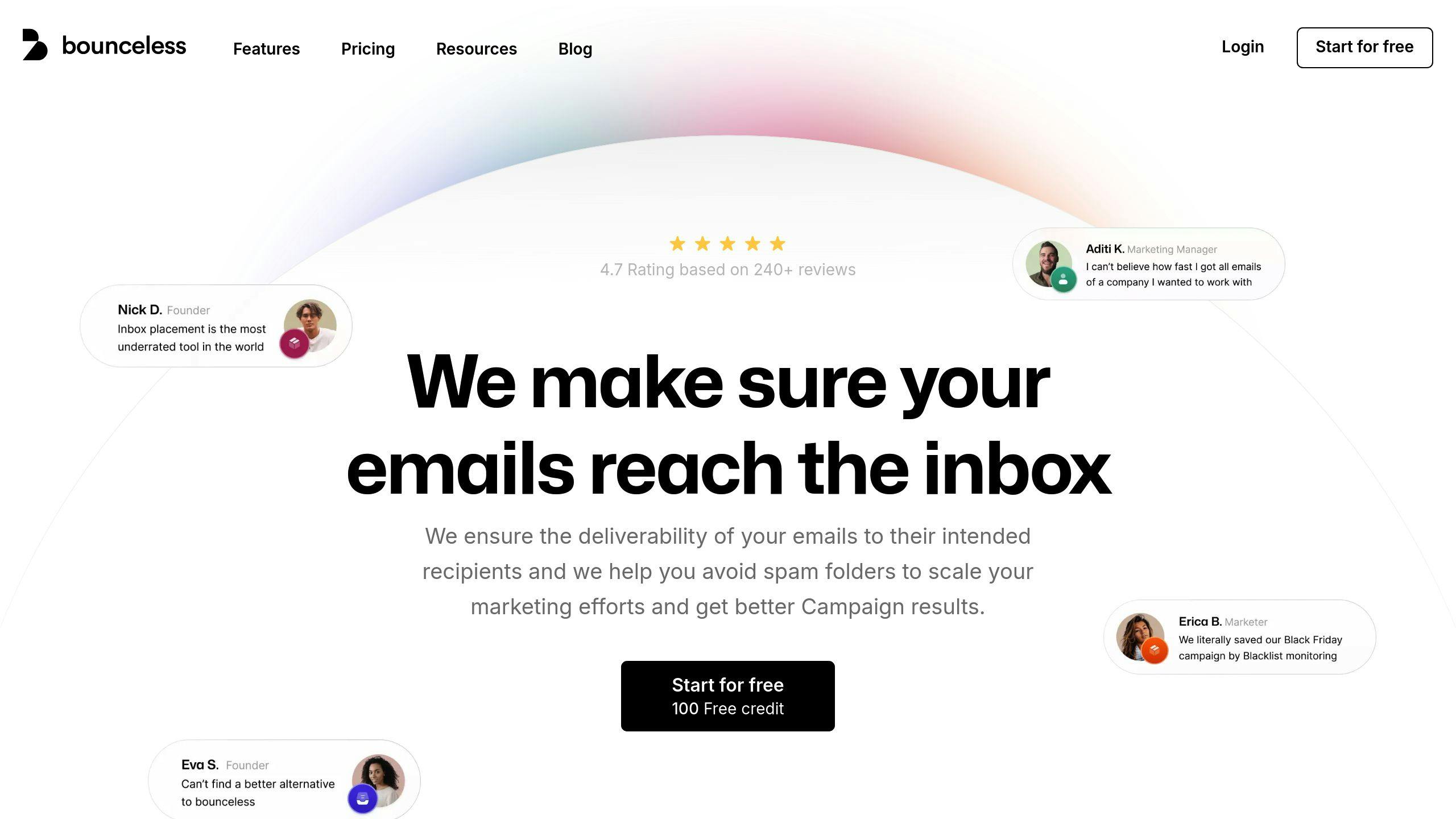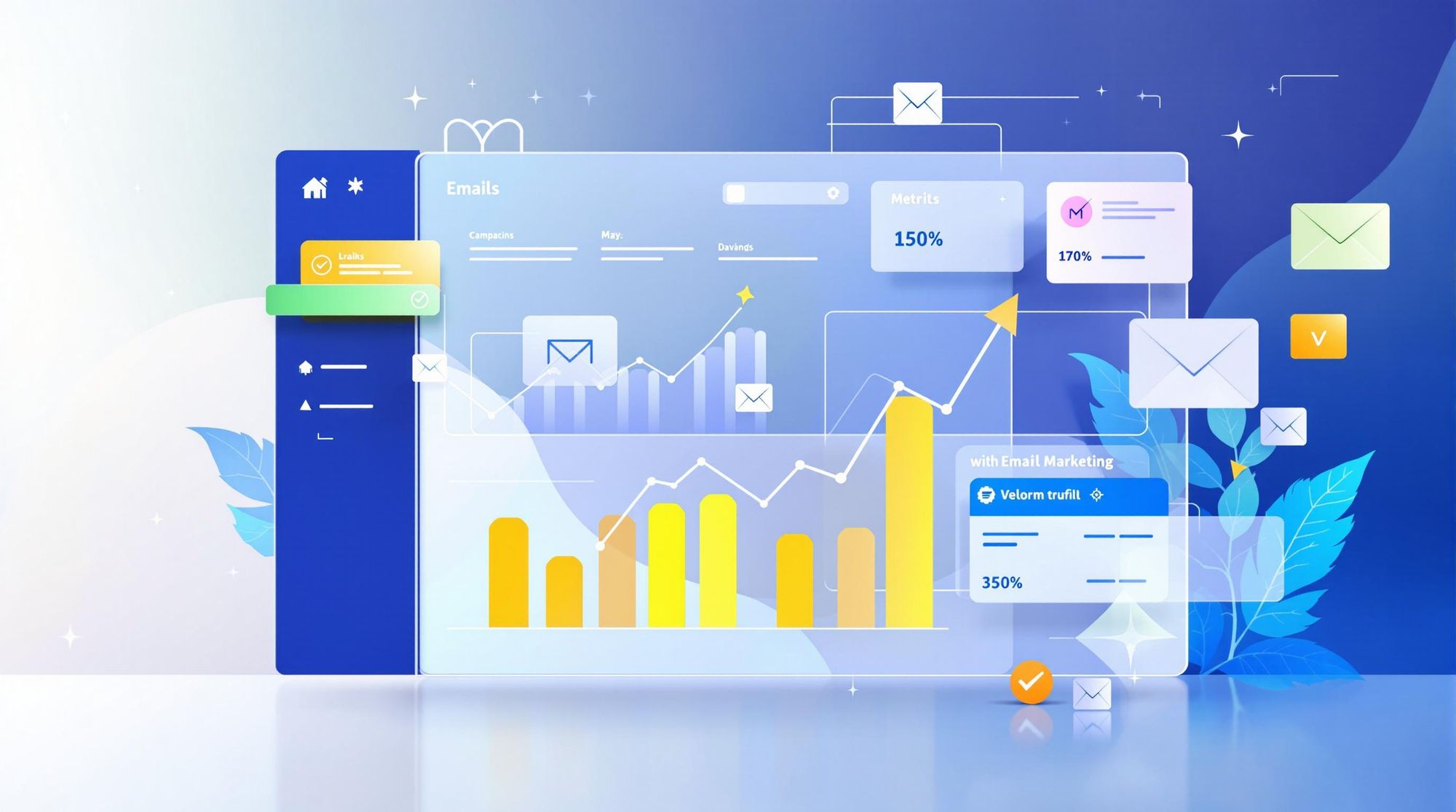Email campaigns can deliver a $36 return for every $1 spent, but success depends on understanding your subscribers' journey. Here's a quick overview of what you need to know:
- Subscriber Stages: Onboarding, Engagement, Conversion, and Retention. Tailor your emails to match each stage for better results.
- Key Metrics to Track:
- Engagement: Open rates, click-through rates.
- Technical: Bounce rates, deliverability.
- Conversion: Purchases, sign-ups.
- Journey: Lifecycle insights to refine strategies.
- Tools to Use:
- Platforms like Mailchimp and ActiveCampaign offer analytics and automation.
- Bounceless.io keeps email lists clean and improves deliverability.
- Integration tools like Zapier streamline workflows.
Why it Matters: Tracking these metrics helps you increase engagement, boost conversions by up to 50%, and reduce list decay by 15-20%. Use AI and multi-channel data to predict behaviors and optimize campaigns for maximum ROI.
Quick Tips:
- Segment your audience by journey stage.
- Personalize content for each phase.
- Regularly clean your email list to maintain accuracy.
- Optimize send times and use AI for better targeting.
Understanding and acting on these insights can transform your email campaigns into a powerful tool for driving engagement and revenue.
Email Marketing Analytics (Advanced Guide)
Subscriber Journey Basics
Understanding how subscribers interact with your email campaigns over time is key to improving engagement and driving conversions. Email analytics can uncover patterns in subscriber behavior, which are essential for building effective campaign strategies.
4 Main Subscriber Stages
1. Onboarding Stage
This is where you welcome new subscribers and set expectations. Engaging, well-crafted welcome emails can increase long-term engagement by 33%.
2. Engagement Stage
At this stage, subscribers actively interact with your content. Delivering emails tailored to their interests and needs is crucial, as engaged subscribers are 3-4 times more likely to take action.
3. Conversion Stage
Here, subscribers perform desired actions like making a purchase or signing up. Personalized emails during this phase can result in transaction rates that are six times higher.
4. Retention Stage
The goal is to maintain relationships with subscribers who have converted. Keeping them engaged helps build loyalty. Monitoring engagement levels is critical to reducing churn. Tools like Bounceless.io can ensure email addresses remain valid and deliverable, minimizing list decay.
Why Track the Subscriber Journey?
Tracking subscriber journeys can significantly improve your email campaigns. Here's how:
| Benefit | Impact |
|---|---|
| Better Targeting | Send content that matches each stage of the journey |
| Increased Engagement | Stage-specific emails can increase click rates by 2-3x |
| Higher Conversions | Targeted campaigns can boost conversions by up to 50% |
| Reduced List Decay | Retain 15-20% more subscribers |
| Improved ROI | Allocate resources more effectively for better returns |
To achieve these outcomes, focus on:
- Segmenting your audience based on their stage in the journey
- Creating content that meets specific needs at each phase
- Reviewing and optimizing key touchpoints regularly
- Using email verification tools to maintain list quality
Understanding the right metrics is also critical for making the most of your subscriber journey tracking efforts.
Must-Track Email Metrics
Every step of the subscriber journey relies on specific data points to gauge engagement, refine strategies, and achieve better outcomes.
Key Engagement Metrics
Tracking how subscribers interact with your emails is the heart of email analytics. These metrics offer insights you can use to fine-tune your campaigns:
| Metric | What It Measures |
|---|---|
| Open Rate | Percentage of recipients who open emails, reflecting how appealing your subject lines are |
| Click-Through Rate | Percentage of clicks on email content, showing how engaging and relevant your content is |
| Conversion Rate | Actions completed by recipients, revealing the campaign's return on investment |
| Bounce Rate | Percentage of undelivered emails, helping maintain a clean and effective email list |
"Understanding engagement trends is critical to inform our email marketing strategy" [2]
With over half of email opens happening on mobile devices (55%), ensuring your emails are mobile-friendly is non-negotiable. Beyond email metrics, consider tracking website visits, time spent on pages, purchase behavior, and content preferences across platforms. These details paint a clearer picture of your subscribers' habits.
Long-term Performance Metrics
To measure the success of your email campaigns over time, focus on metrics that highlight subscriber loyalty and overall value:
| Long-term Metric | Purpose and Impact |
|---|---|
| Subscriber Retention | Tracks how stable your list is, helping you identify when re-engagement efforts are needed |
| Customer Lifetime Value | Measures revenue generated per subscriber, aiding in audience segmentation and prioritizing high-value groups |
| Engagement Trends | Monitors changes in subscriber interest, guiding your content strategy |
| List Growth Rate | Evaluates how quickly your audience is expanding, helping you refine acquisition strategies |
Using tools like Bounceless.io can help you keep your email list clean by identifying and removing invalid addresses. This ensures your metrics are based on real subscriber behavior, leading to more accurate data and better deliverability.
Once you’re tracking these metrics, the next challenge is finding the right tools to analyze and act on this data effectively.
Email Analytics Software Options
To run effective email marketing campaigns, you need tools that can track performance and provide insights into your subscribers' behavior. Choosing the right software ensures accurate data and helps you make smarter decisions.
Built-in Platform Analytics
Platforms like Mailchimp and ActiveCampaign come with advanced analytics features that help you monitor campaigns and predict outcomes. For instance, Mailchimp's 2024 update introduced advanced segmentation, allowing users to track up to 25 custom attributes for real-time insights. ActiveCampaign takes it further with its predictive analytics suite, offering AI-driven content recommendations to boost engagement.
| Platform Feature | Mailchimp | ActiveCampaign |
|---|---|---|
| Journey Mapping | Visual flow builder | Automation map |
| Predictive Analytics | Basic scoring | Advanced AI predictions |
| Custom Reports | Up to 100 metrics | Unlimited metrics |
| A/B Testing | Subject lines, content | Full journey testing |
Email List Management with Bounceless.io

Bounceless.io is a tool designed to keep your email lists clean and reliable, which is crucial for accurate analytics. Its verification system ensures your data remains trustworthy by identifying invalid emails and spam traps.
"Our platform's spam trap detection and SMTP validation have helped businesses reduce bounce rates by an average of 98% within the first month of implementation", states Bounceless.io's technical documentation [2].
By integrating with platforms like Mailchimp, Bounceless.io ensures your campaigns are built on solid data, improving overall performance.
Data Integration Tools
For deeper insights, tools like Segment and Zapier can help streamline your data. Segment processes over 1 trillion API calls each month, offering robust multi-channel analysis for tracking subscriber journeys. Zapier, on the other hand, simplifies workflows, such as syncing Bounceless.io with Mailchimp to automatically remove invalid emails.
Whether you need quick middleware solutions like Zapier or fully customizable API integrations, these tools adapt to your business needs. They don’t just deliver data - they help you visualize and improve every step of the subscriber journey. With these insights, you can fine-tune your campaigns and address areas where engagement drops off.
Using Data to Improve Campaigns
Finding and Fixing Drop-off Points
Research from Campaign Refinery shows that 17% of customers might abandon a brand after just one bad experience [1]. To prevent this, keep an eye on unsubscribe rates (the industry average is 0.26%), falling open rates, and declining click-through trends. These metrics can help you spot where engagement is dropping off.
For example, Campaign Monitor highlighted how one company boosted their open rates by 25% and saw a 15% rise in conversions by segmenting their email list and creating targeted win-back campaigns [2].
Once you pinpoint where people are losing interest, adjust your content strategy to pull them back in.
Email Content Targeting
Match your email content to where subscribers are in their journey. For example:
- New subscribers: Welcome series emails
- Active buyers: Exclusive offers
- At-risk subscribers: Re-engagement campaigns
- Dormant subscribers: High-value incentives
This tailored approach keeps your audience engaged and helps reduce churn.
Send Time Optimization
When you send your emails can make or break your campaign's performance. Using analytics, you can figure out the best times to connect with your audience.
Here are some tips for better timing:
- Track open rates at different times of the day
- Consider your audience's time zones
- Watch for seasonal changes in engagement
- Use automation to send emails when subscribers are most likely to be active
For instance, emails sent between 10 AM and 11 AM often perform better in terms of open rates [2]. That said, testing is key - your audience's habits might differ based on their industry or demographics.
While timing is important, combining it with personalized content and engagement tactics is what really drives results.
Next-Gen Analytics Methods
Predicting Subscriber Actions
Machine learning helps predict subscriber behavior by analyzing past data to identify who might engage or disengage. These predictive tools allow marketers to adjust campaigns ahead of time, addressing potential issues before they arise. By anticipating what subscribers need or want, companies can send more relevant content at the right time.
AI goes even further by automating and fine-tuning email strategies as new data comes in.
AI Email Optimization
AI has changed how email campaigns are managed by automating and improving key steps. For example, a retail brand using AI to optimize their emails reported a 25% boost in open rates and a 15% jump in conversions. AI achieves this by analyzing subscriber behavior, tailoring content, and selecting the best times to send emails - all while learning from each interaction to get better over time.
While AI sharpens email performance, combining data from different channels paints a clearer picture of subscriber activity.
Multi-Channel Data Analysis
Tracking the subscriber journey effectively means pulling data from various channels to get a full picture of engagement. Here's how different sources contribute:
| Data Source | Key Metrics |
|---|---|
| Opens, Clicks, Replies | |
| Website | Page Visits, Click Paths |
| Social Media | Likes, Shares, Comments |
| Customer Support | Response Times, Feedback |
Bringing together data from these touchpoints helps marketers understand the entire subscriber journey. This makes it easier to spot critical engagement opportunities and create campaigns that feel personal across all platforms.
To get the most out of these advanced analytics methods, make sure your data is accurate and your systems are well-connected. Regularly reviewing and fine-tuning AI-driven campaigns is key to staying on track and delivering strong results.
Summary
Analyzing email campaign performance is key to understanding subscriber behavior and improving the results of your campaigns. By focusing on important metrics and using advanced tools, marketers can design more targeted and effective emails.
The success of an email campaign hinges on tracking metrics like open rates, click-through rates, and deliverability. These numbers give a clear picture of what’s working and where adjustments might be needed.
"Key performance indicators provide clear insights into campaign successes and areas for improvement."
Here’s how to boost your campaign’s impact:
- Track Metrics Regularly: Look for patterns and areas to improve.
- Keep Your List Clean: Accurate and updated lists improve deliverability.
- Use AI and Cross-Channel Data: Personalize emails and optimize campaigns using insights from multiple platforms.
The best campaigns deliver value with tailored content while ensuring technical elements like deliverability and list accuracy are top-notch. The factors that matter most include:
- Regular Monitoring: Keep an eye on performance data to stay ahead.
- Integrated Data: Combine email insights with data from websites and social media for a complete view of your audience.
- AI Tools: Use predictive analytics and automation to create highly personalized experiences.

